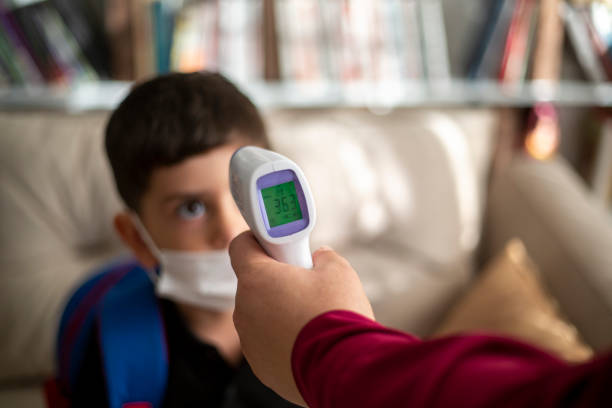Temperature is one of the most essential vital signs to assess a patient’s health. An abnormal body temperature can indicate infection, or inflammation. In recent years, remote body temperature monitoring technology has emerged as a preventive care method. This type of tracking allows physicians to regularly monitor a patient’s temperature changes to identify infection and other health risks and determine treatments.
Instead of relying solely on periodic in-person temperature checks, healthcare providers can now use connected devices to keep track of patients’ temperatures from afar. As this technology continues advancing, temperature data collection is being reimagined. Technology improves care in several key ways that we will outline in this article.
Remote Body Temperature Monitoring
Temperature patterns can vary substantially between individuals based on age, medications, chronic conditions, and other factors. By examining continuous remote monitoring data, providers can clarify each patient’s normal temperature range and customize monitoring thresholds appropriately. This enables more personalized care rather than applying generic norms. Rich temperature data also helps inform individualized treatment plans. This is especially true in sepsis.
Sepsis is the body’s extreme response to an infection. Fever is understood as an adaptive immune system response to infection. In sepsis, fever is a common symptom. A large, contemporary, multicenter sample of patients admitted to the hospital for sepsis reported that “each elapsed hour between presentation and antibiotic administration was associated with a 9% increase in the odds of mortality in patients with sepsis of all severity strata.”
A large, contemporary, multicenter study examined patients with sepsis in the emergency department. The study found that hourly delays in initial antibiotic administration were associated with increased odds of hospital mortality, even among patients who received antibiotics within 6 hours of presentation. The increased mortality odds were observed across all sepsis severity levels. However, the greatest increases were seen in patients with septic shock. Therefore, the findings highlight the importance of rapid antibiotic administration in sepsis, as mortality odds rise progressively with each hour of delay. Quicker treatment is associated with better outcomes across the board.
Given that fever is a common symptom of sepsis and a sign of the body’s immune response, along with evidence that rapid treatment is crucial, continuous remote temperature monitoring of these patients could facilitate earlier detection of fever spikes – allowing physicians to identify suspected sepsis cases sooner and administer life-saving antibiotics within that critical first hour.
Continuous Data Collection & Adherence
Traditionally, temperature is measured only during office visits or periodically by nurses. This provides limited snapshots that don’t show fluctuations between measurements. Remote body temperature monitoring enables continuous tracking of data over time. Some remote patient monitoring thermometers are used similarly to traditional thermometers. Only the RPM thermometer transmits the temperature reading directly to their physician for review. Patients can also wear connected devices that passively record their temperature throughout the day or night. Both options provide richer data for detecting emerging fevers and other temperature-related health changes.
Earlier Health Change Detection
By tracking temperature continuously, remote body temperature monitoring systems can identify subtle changes earlier than periodic measurement allows. Even slight temperature elevations can signal developing infections, inflammation, graft complications, etc. Catching changes quickly allows earlier intervention, which can improve outcomes. Continuous data also helps determine whether a temperature change is part of an emerging or incidental pattern.
In one study, 2,161 patients submitted questionnaires during a COVID-19 remote patient monitoring program. Of these patients, 239 (11%) had a temperature above 100.3°F. Elevated temperature was the most common abnormality triggering an alert, at 76%. This data reinforces that fever can persist as a symptom in COVID-19 patients even after hospitalization.
Overall, 34% of patients who completed a questionnaire triggered a symptom alert during monitoring. However, 66% of patients could be monitored passively without intervention. This indicates that remote body temperature monitoring allowed early identification of persistent fevers in recovering COVID-19 patients. While concerning symptoms prompted follow-up in some patients, remote body temperature monitoring was a scalable way to passively monitor most discharged patients remotely.
Tenovi Cellular-Connected Remote Body Temperature Monitoring
Tenovi’s FDA-cleared RPM thermometer transmits data wirelessly through the Tenovi cellular Gateway to the Tenovi cloud with one touch. Physicians can view the vital sign readings in the Tenovi dashboard or on their platform. The Tenovi thermometer offers eardrum and no-touch forehead modes for accurate temperature measurements (+/-0.2°C; +/-0.3°C) in adults and children.
You can schedule a free demo to learn more about leveraging Tenovi’s FDA-cleared remote patient monitoring devices and software service solutions.
Understanding Remote Body Temperature Monitoring
While adoption is still early, remote body temperature monitoring technology appears poised to expand significantly in the coming years. By enabling continuous data collection and earlier change detection, these devices promise to support more responsive, efficient, and personalized care. As the technology develops further, remote temperature monitoring could soon become integral to healthcare workflows across settings.


